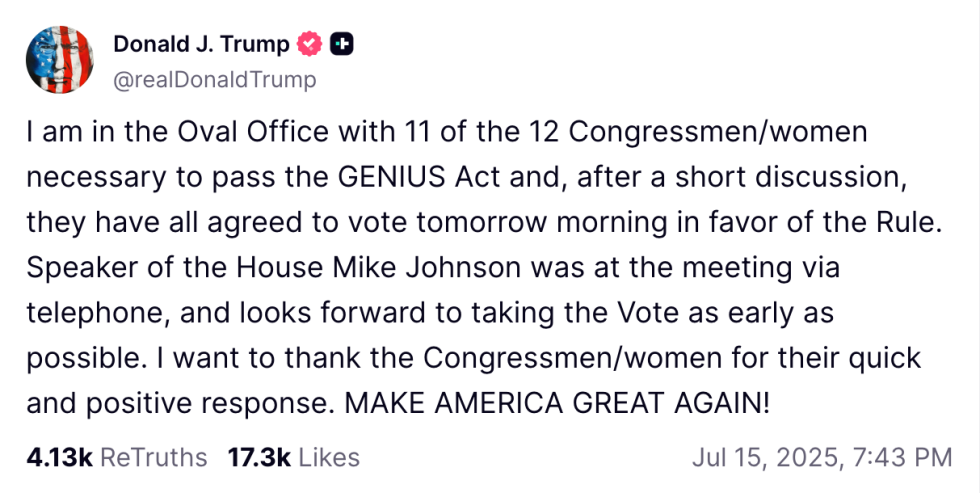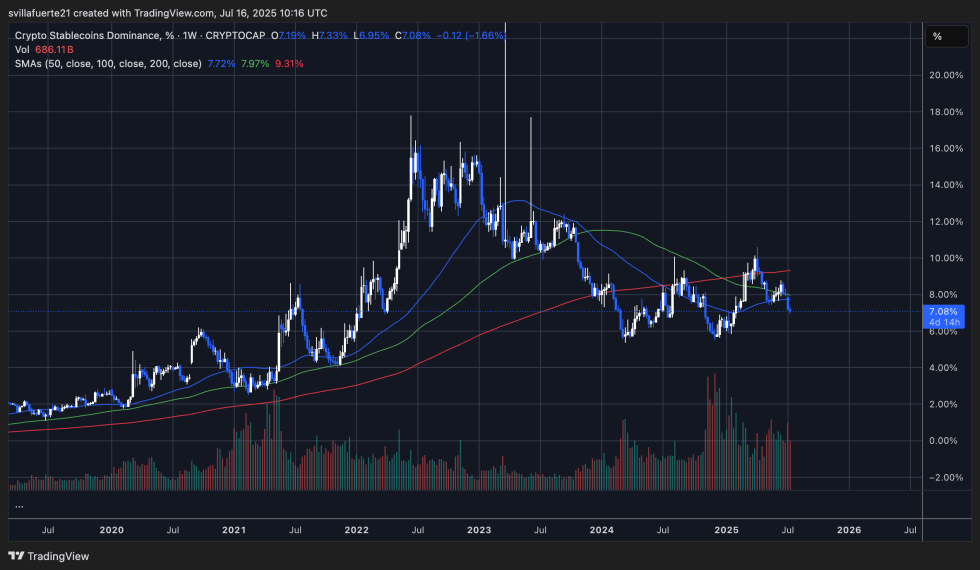In a surprising turn of events during the highly anticipated “Crypto Week,” the US House of Representatives voted against the GENIUS Act yesterday, despite widespread expectations that it would pass alongside two other crypto-related bills. The decision sent ripples through the crypto market, catching many investors and industry participants off guard, as the GENIUS Act was seen as a key step toward establishing clearer regulatory guidelines for stablecoins.
One of the most vocal opponents of the bill was US Representative Marjorie Taylor Greene, who represents Georgia’s 14th District and currently serves as Chairwoman of the DOGE Committee. In a statement following the vote, Greene explained that her opposition stemmed from the bill’s failure to include a ban on Central Bank Digital Currencies (CBDCs). She emphasized that Americans do not want a government-controlled digital dollar and that Republicans have a duty to defend financial freedom and privacy by opposing CBDCs.
The unexpected rejection of the GENIUS Act raises new questions about the direction of crypto regulation in the United States and highlights the growing divide over CBDC policy. As lawmakers continue to debate the future of digital finance, the spotlight now turns to how Congress will proceed.
CBDC Debate Ignites As Trump Asserts GENIUS Act Vote Will Pass
US Representative Marjorie Taylor Greene also criticized Speaker Mike Johnson for not allowing members of Congress to submit amendments to the legislation.
“Americans do not want a government-controlled Central Bank Digital Currency,” Greene declared. “Republicans have a duty to ban CBDC.” She pointed to former President Donald Trump’s executive order from January 23, which explicitly called for a CBDC ban, arguing that Congress should reflect that position within the GENIUS Act.
The dispute over CBDCs has now emerged as a key dividing line within the broader crypto policy debate. For critics like Greene, a CBDC represents government overreach and a direct threat to individual financial privacy, concerns that have gained traction among conservatives.
Despite the failed vote, US President Donald Trump struck an optimistic tone on his Truth Social account, signaling that the legislative push is far from over. “I am in the Oval Office with 11 of the 12 Congressmen/women necessary to pass the GENIUS Act and, after a short discussion, they have all agreed to vote tomorrow morning in favor of the Rule,” he wrote.
If Wednesday’s vote succeeds, it could breathe new life into the GENIUS Act and reframe the discussion around crypto regulation. However, the growing insistence on a CBDC ban may continue to complicate bipartisan support, especially as the issue becomes more deeply entangled in the 2024 presidential race and the future of financial sovereignty in the US
Stablecoin Dominance Drops To 7.08% As Risk Appetite Rises
The weekly chart of stablecoin dominance shows a clear downward shift, with the metric currently sitting at 7.08%, marking a steady decline from its recent highs above 9%. This trend suggests that capital is rotating out of stablecoins and into more volatile crypto assets like Bitcoin and Ethereum, a common pattern during periods of renewed market confidence.
Stablecoin dominance is now trading below all key moving averages: the 50-week (7.72%), 100-week (7.97%), and 200-week (9.31%) SMAs. This technical breakdown highlights a weakening position for stablecoins relative to the broader crypto market. Historically, when dominance falls below these levels, it signals growing risk appetite and a shift toward the accumulation of growth assets, which aligns with current bullish momentum across altcoins and ETH.
This decline in dominance—despite total stablecoin supply continuing to rise—is a bullish macro signal. It shows that liquidity is present and moving into the market, not out of it, supporting the case for further upside in the months ahead.
Featured image from Dall-E, chart from TradingView

